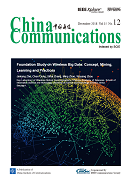COMMUNICATIONS THEORIES & SYSTEMS
Syed Tariq Shah, Minsu Shin, Young Min Kwon, JaeSheung Shin, Ae-Soon Park, Min Young Chung
2018, 15(12): 159-173.
Recent years have witnessed a huge demand for ubiquitous communications services from continuously moving users. In order to provide seamless network services to high-mobility users, one of the promising solution proposed by 3GPP is the deployment of moving-relays. In this article, we introduce the concept of Moving-Personal-Cell (mPC), which is a type of moving-relays. mPC is a user-centric network, which aims to provide reliable network services to moving users. A mPC receives data-traffic from eNB and its neighboring mPCs via wireless backhaul and sidehual links respectively and forwards the received data to its serving users. In addition to this, mPC can also increase the network capacity by caching and distributing the popular contents to its serving users. Besides these pros, the mPC also has some limitations, as its performance is highly affected by cross-tier and co-tier interferences. In this article, we analyze the effect of these interferences on mPCs performance. Our results show that the performance of mPC network is equally affected by the capacity of wireless backhaul, sidehaul, and access links. Moreover, since mPCs accommodate data traffic from wireless backhaul, sidehaul links, and content cache, their performance is also affected by the ratio of data-traffic delivered via these links.
